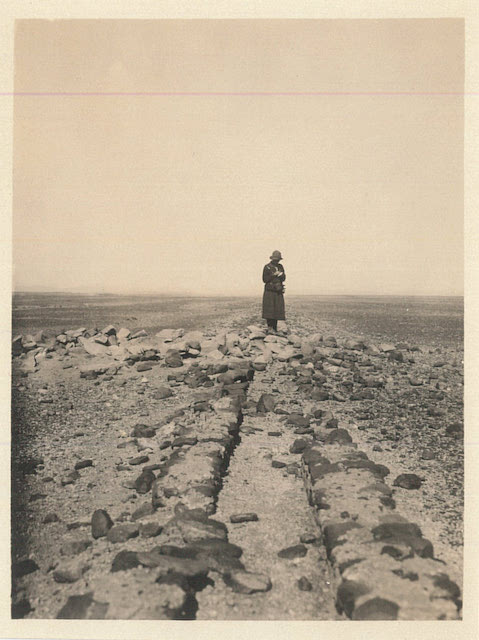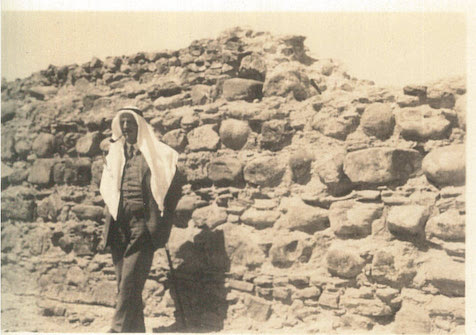|
[by Agnes Conway] After calling on the Governor of Ma’an [Khalaf Bey Atell] and Mr Strange, (Intelligence Officer to the Air Force) Mr Horsfield went to Ain Musa with one ton truck of luggage; met his 6 men who had ridden over from Jerash and sent them down to Petra to start preparing the Camp. He came back to Ma’an for the night.
Reference: Conway, A. 1929 (transcribed by A. Thornton). Petra Exploration Fund Diary. "Business Papers to be Kept", Horsfield Collection Box 8, UCL Institute of Archaeology, 21 March: 1.
[by Agnes Conway] Mr Horsfield left very early for Petra with the rest of the luggage and slept there. Dr Nielsen and I spent the morning following the aqueduct still further East from Unum el Trab; then North to the bank of the Wady Wahadan, where it follows the Wady West to the railway bridge, and past Ma'an el Sanmijjeto El Basta, on the watershed between Ma'an and Petra. A khan near the Wady Wahadan had the same pottery as the Hammam and Unum el Trab. A glazed stone found at Hammam today is Byzantine. A. C. took compass bearings and photographs of the aqueduct and made a rough map of the system, which can be fitted in to Musil’s map of the Ma’an area in his “Northern Hedjaz”. The date of such an enormous irrigation system is uncertain. The masonry of the Hammam, in tiers of thick and thin stones, is thought by Mr H and by Pere Savignac to be perhaps Roman. Ma’an is never mentioned by classical authors, and A.E.C. thinks the whole system more likely to be Byzantine, about which period at Ma’an there are no European sources. Dr Nielsen would like to prove the system to be Sabaean or Minaean, as the occupation at that time is known to have been extensive; but there are no signs of actual pre-Roman remains above ground.
The system thus far has only been cursorily and inadequately described in Musil’s Northern Hedjaz. He evidently, without a car, could not cover the area, and nor could any of the earlier visitors. In the afternoon we drove on the Akaba road to the head of the Star Pass; from which the view down on to a plain studded with fantastic and detached hills, seen in a violet light, is extraordinarily strange and beautiful. Reference: Conway, A. 1929 (transcribed by A. Thornton). Petra Exploration Fund Diary. "Business Papers to be Kept", Horsfield Collection Box 8, UCL Institute of Archaeology, 22 March: 2-3. |
Categories
All
Archives |


 RSS Feed
RSS Feed